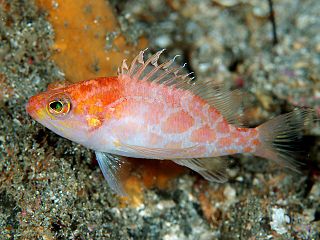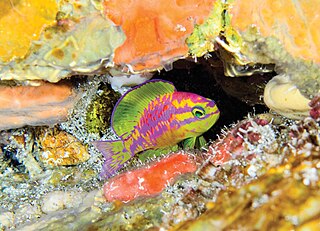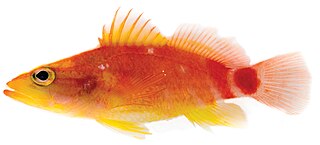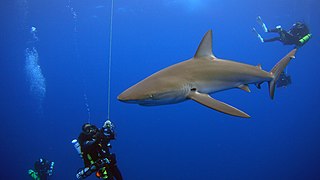
Plectranthias is a genus of ray-finned fish in the subfamily Anthiinae, part of the family Serranidae, the groupers and sea basses. They are found in the Atlantic, Indian and Pacific Ocean.

Cirrhilabrus, the fairy wrasses, is a genus of fish in the family Labridae native to coral reefs and nearby habitats in the Indo-Pacific region. They are brightly colored and do not surpass 16 cm (6.3 in) in length. Males are larger and more colorful than females. They are commonly kept in aquaria.

The puddingwife wrasse, Halichoeres radiatus, is a species of wrasse native to the western Atlantic Ocean from North Carolina to Bermuda, through the West Indies and Gulf of Mexico, to offshore islands of Brazil, being absent from Brazilian coastal waters. It can be found on reefs at depths from 2 to 55 m, with younger fish up to subadults being found in much shallower waters from 1 to 5 m. This species can reach 51 cm (20 in) in total length, though most do not exceed 40 cm (16 in). This species is of minor importance to local commercial fisheries and can be found in the aquarium trade.

Roa is a genus of butterflyfishes native to the Indian and Pacific oceans. The six species are widely distributed: R. australis near Australia, R. excelsa near Hawaii and nearby islands, R. jayakari near India, R. modesta near Japan and China, R. rumsfeldi in the Philippines, and R. haraguchiae near Japan and the Philippines.

Haemulon is a genus of fish in the grunt family known as the scaled-fin grunts. Most are found in the western Atlantic Ocean, with a few species known from the eastern Pacific Ocean. This genus is considered to be one of the most important fish groups of the coral reefs of Brazil due to its commercial value and crucial ecological role.

A mesophotic coral reef or mesophotic coral ecosystem (MCE), originally from the Latin word meso (meaning middle) and photic (meaning light), is characterized by the presence of both light-dependent coral and algae, and organisms that can be found in water with low light penetration. Mesophotic coral ecosystems occur at depths beyond those typically associated with coral reefs as the mesophotic ranges from brightly lit to some areas where light does not reach. Mesophotic coral ecosystem (MCEs) is a new, widely-adopted term used to refer to mesophotic coral reefs, as opposed to other similar terms like "deep coral reef communities" and "twilight zone", since those terms sometimes are confused due to their unclear, interchangeable nature. Many species of fish and corals are endemic to the MCEs making these ecosystems a crucial component in maintaining global diversity. Recently, there has been increased focus on the MCEs as these reefs are a crucial part of the coral reef systems serving as a potential refuge area for shallow coral reef taxa such as coral and sponges. Advances in recent technologies such as remotely operated underwater vehicles (ROVs) and autonomous underwater vehicles (AUVs) have enabled humans to conduct further research on these ecosystems and monitor these marine environments.

Liopropoma is a genus of marine ray-finned fish, related to the groupers and included in the subfamily Epinephelinae, part of the family Serranidae, which also includes the anthias and sea basses. They are sometimes seen in the marine aquarium trade.

Tosanoides aphrodite, the Aphrodite anthias, is a species of marine ray-finned fish, from the subfamily Anthiinae part of the family Serranidae, the groupers and sea basses. It was discovered in the Atlantic Ocean in 2018, the only one in its genus to be discovered there. It was first identified by Luiz A. Rocha and Hudson Pinheiro, staff members of the California Academy of Sciences. The fish is electric pink and yellow and has bright green fins. It was discovered on a remote Brazilian archipelago in the Atlantic Ocean and can be distinguished by 15-16 soft dorsal fin rays and 9 anal fin rays. They are sexually dichromatic, meaning the males and females are different colors. It is named after Aphrodite, the Greek goddess of love and beauty.

Cirrhilabrus wakanda, the vibranium fairy wrasse, is a species of fairy wrasse from mesophotic reefs at depths of 50–100 m (160–330 ft) in the western Indian Ocean off Tanzania and Mozambique. It was first collected off the coast of Zanzibar, Tanzania by scientists from the California Academy of Sciences. Its separation from the very similar C. rubrisquamis of the Chagos Islands needs confirmation.

Chromis bowesi, known as the rhomboid chromis, is a species of damselfish in the family Pomacentridae. This species was first described in 2019 by Luiz A. Rocha and colleagues, along with Chromis hangganan and Chromis gunting, discovered and known from Verde Island, Batangas Bay and Puerto Galera Bay, in the Philippines.

Halichoeres burekae, the Mardi Gras wrasse, is a species of wrasse native to the Gulf of Mexico. The species was first described from the Flower Garden Banks National Marine Sanctuary, in the northwestern Gulf of Mexico, but has since been recorded in other areas of the southern Gulf of Mexico. Because it is a small species that feeds on plankton in the water column, it is likely a preferred prey for invasive Lionfish. It also has a very restricted range, and corresponding relatively small population, what resulted in this species being listed as Endangered in the IUCN Red List.

Plectranthias ahiahiata, the sunset perchlet, is a fish of the family Serranidae, subfamily Anthiinae. It is believed to be endemic to Rapa Nui in the South Pacific. It was discovered at 90m depth during mesophotic coral ecosystem exploration by the deep diving team from the California Academy of Sciences.

Cirrhilabrus earlei is a species of fairy wrasse. They occur in the Western Central Pacific, Palau and Micronesia. In 2001 John Randall and Richard Pyle officially documented and described the species. Cirrhilabrus earlei is the known to the twilight reefs of Palau and the Majuro Atoll in the Marshall Islands. They live under depth range of 60–92 m, and its length is 6.9 cm SL. Male Cirrhilabrus earlei are adorned with sword-shaped tails, the tiny female species are same as male stimulates the male into the nuptial.

Cirrhilabrus finifenmaa, also known by its common name rose-veiled fairy wrasse, is a rainbow-colored wrasse that is native to the reefs of the Maldives.

Scarus zelindae is a species of fish of the Scaridae family in the order Perciformes. This species of Parrotfish can be brown, blue, green, yellow, and purple and can change their colors several times throughout their lifetime. They live for about 5–7 years and can be found in the southwestern Atlantic Ocean, primarily in Brazilian waters.
Centropyge nahackyi, also called Nahacky's angelfish, is a small pygmy angelfish found on deeper drop-offs around Johnston Island and Hawaii.

Randall Kosaki is a research ecologist at the NOAA Papahānaumokuākea Marine National Monument. His expertise is in the behavioral ecology, taxonomy, and biogeography of Pacific coral reef fishes.

Plectranthias hinano, or Hinano's perchlet, is a species of fish in the family Serranidae occurring in the north-western Pacific Ocean.

Plectranthias polygonius, the polygon perchlet, is a species of fish in the family Serranidae occurring in the Pacific Ocean.
Terelabrus toretore is a species of wrasse native to deep reefs in Tahiti, French Polynesia. It was originally described based on two specimens collected in the mesophotic zone of a coral reef off the coast of Tahiti, the species has a bright red color with a horizontal white stripe dividing the body and a yellow tail.


















